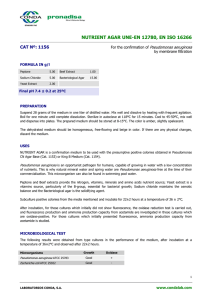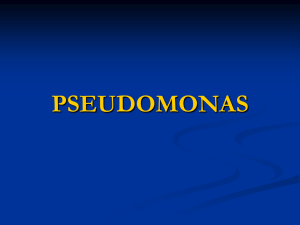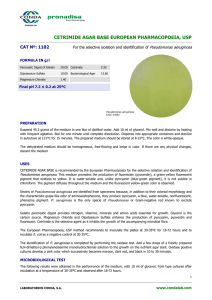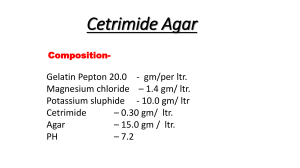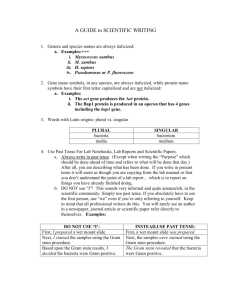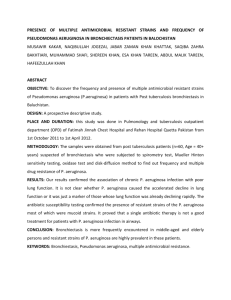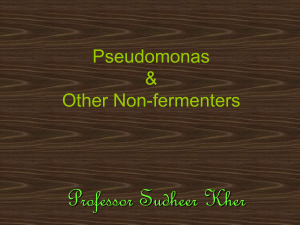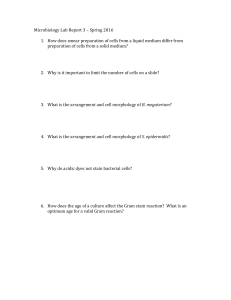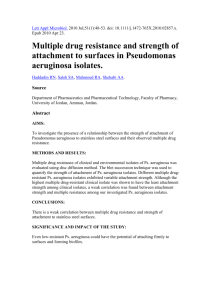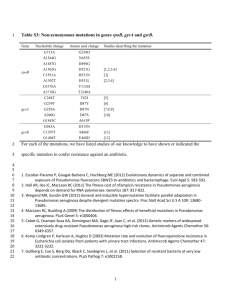Diagnostic microbiology lecture: 5 Pseudomonas Abed ElKader
advertisement
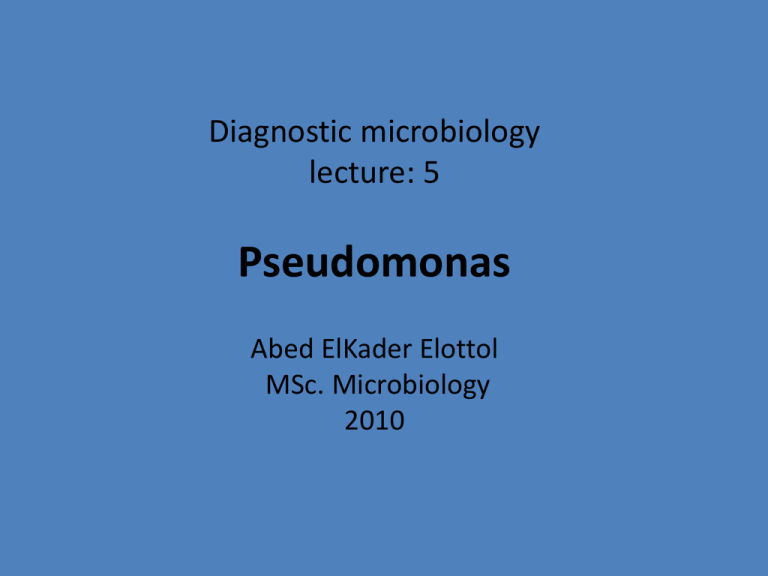
Diagnostic microbiology lecture: 5 Pseudomonas Abed ElKader Elottol MSc. Microbiology 2010 Pathogenic species 1. Pseudomonas aeruginosa 2. Ps. pseudomallei 3. Ps. mallei Pseudomonas aeruginosa May grow in : • Disinfectants • Contact lens solutions • Medicinal solutions • Humidifiers of respirators GENERAL CHARACTERISTICS 1. Obligate aerobic, gram negative bacilli indistinguishable from Enterobacteriaceae. 2. Non-lactose fermenter 3. Oxidase positive 4. Glucose oxidizer 5. Catalase positive 6. Citrate positive 7. Motile by a polar flagella 8. Produces exotoxin A = Inhibits protein synthesis and produces tissue necrosis. 9. Produces collagenase which hydrolysis collagen 10. produces elastase which hydrolysis elastin and is used by the organism for invasion. 11. It produces pigments 11.1 pyocyanin = blue green pigment 11.2 pyoveridin = Yellow- fluorescence. PATHOGENICITY •Ps. aeruginosa is an opportunistic pathogen that infect immunocompromized patient. •Usually causes hard to treat nosocomial infections. • It show resistance to most antibiotics. DISEASES caused by Ps. aeruginosa include: 1. Urinary tract infection (UTI) 6. Sepsis 2. Otitis media 7. Burn infection 3. Wound infection 8. Meningitis 4. Sinus infection 9. Endocarditis 5. Bronchopneumonia IDENTIFICATION 1. Gram staining: Ps. aeruginosa is indistinguishable from other gram negative bacilli. Therefore there is a little significance for gram staining. 2.Culture: Ps. aeruginosa grow well on ordinary media such as Blood Agar, Nutrient Agar and MacConkey Agar. = Colonies are 2-4 mm in diameter, slightly convex, grayish the smell like grape and are often hemolytic. = On Nutrient Agar, Ps. aeruginosa is easily recognized by the diffused blue-green pigmentation. Biochemical tests Serological typing: This is performed through an agglutination test based on the reactivity of somatic O antigens of intact cell with specific antisera. Cross reactivity may occur in 10-11% of cases. Pyocin typing: Pyocin is an antibiotic produced by Pseudomonas aeruginosa that can inhibit the growth of other bacterial species. This test is less commonly used. ANTIBIOTIC SUSCEPTIBILITY Ps. aeruginosa is typically resistant to commonly used antibiotics. = Aminoglycosides (Amikacin, gentamicin), polymyxins and colistin are used in the treatment of this organism. 3rd & 4th generation cephalosporins. = Mg++ and Ca++ must be added to the growth medium used in the sensitivity testing. Pseudomonas pseudomallei Burkholderia pseudomallei DISEASE: Melioidosis: Uncommon tropical disease= Pulmonary manifestation of the disease which is usually confused with tuberculosis. Characteristics: 1. Non pyocyanin producer. 2. Esculin hydrolysis = Positive 3. Lactose oxidation = Positive NB: These characteristics are used to differentiate it from Ps. aeruginosa. Pseudomonas mallei Burkholderia mallei • DISEASE: Glander: • Ulcerating, tubercle-like nodules forms in the lungs, superficial lymph nodes and mucus membrane. • This organism could be differentiated from other Psudomonas species by carbohydrate oxidation test. Acinetobacter Pathogenic species Acinetobacter calcoaceticus DISEASE: It is an oppurtinistic pathogen. In patients with burns or with immunologic deficiency, they can produce sepsis or pneumonia. Diagnostic tests On gram stained smears it mimic the appearance of Niesseria and thus sometimes called (mima), but it is rapidly differentiated from Niesseria by negative Oxidase test. 1. Non motile 2. Resistant to penicillin 3. Grow well on MacConkey Agar. Achromobacter Pathogenic species Achromobacter xylosoxidans now known as Alcaligenes denitrificans DISEASES: 1. Septicemia 2. Otitis media 3. Meningitis 4. Wound infection 5. Urinary tract infection. Oxidase positive, catalase positive Motile non lactose fermenter CHARACTERISTICS: 1. It grow well on MacConkey Agar 2. Oxidase positive 3. Motile by peritrichous flagella 4. Acidification of Oxidation-Fermentation (OF) glucose and xylose. Alcaligenes Pathogenic species: 1. A. faecalis = recovered from blood, sputum and urine. 2. A. odorans = recovered from urine 3. A. denitrificans CHARACTERISTICS: 1. Motile by peritrichous flagella 2. Oxidase positive 3. Hydrolysis urea 4. Citrate positive 5. Inability to utilize OF carbohydrates used acetate Discriminating Characteristics of Members of the Genus Alcaligenes Treatment Susceptible to cephalosporins, such as carbenicillin. Also to minocycline, doxycycline and polymyxin B.
